The new chemical technology lab of the Organisation for the Prohibition of Chemical Weapons (OPCW) officially opened its doors on 12 May. The launch of the ChemTech Centre coincides with a historic milestone for the organisation that may now be just weeks away: the elimination of all declared stockpiles of chemical weapons in the world. As the OPCW begins the next stage of its role as chemical weapons watchdog, these labs will provide the upgraded capabilities it needs to investigate alleged uses of chemical weapons and check that chemicals are being used for peaceful purposes.
The OPCW’s new ChemTech Centre just outside The Hague in the Netherlands was built with €34 million (£30 million) in contributions from 57 members of the CWC and other donors, including chemical societies. Construction of the centre began a year-and-a-half ago and it provides more modern and sophisticated facilities for the organisation. The centre will give the OPCW new scientific capabilities and the ability to train more personnel to keep up with a rapidly changing world. New challenges include the threat of non-state actors producing chemical weapons for indiscriminate attacks or countries attempting to use chemical weapons clandestinely. Other evolving threats include novel chemical weapons and the possibility of artificial intelligence being employed to create them. The centre will give the OPCW the opportunity to spend more time on chemical weapon forensics and checking up on the production of dual use chemicals that could potentially be employed militarily. This includes chemicals such as thiodiglycol, which is used by industry to produce pesticides, plastics and dyes, but can also be used to make mustard gas, or organophosphates that can be turned into nerve agents such as sarin.
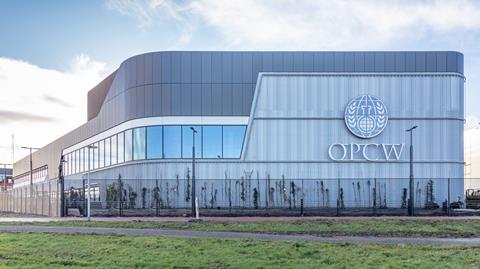
The Chemical Weapons Convention (CWC) was drawn up 30 years ago, with the aim of creating a world free of these weapons, where chemistry is used for ‘peace, progress and prosperity’. When it came into force in 1997, the majority of the world’s nations had signed up to its key aims of eliminating stockpiles of chemical munitions and never employing chemistry to create weapons of mass destruction. Now, 193 countries are signatories to it, with only Egypt, Israel, South Sudan and North Korea outside the auspices of the treaty.
The OPCW’s role is to oversee the implementation of the CWC and the end of chemical armaments. It does this by monitoring the destruction of stockpiles of chemical weapons declared under the treaty, attending on site when a chemical weapon is claimed to have been used and ensuring the peaceful uses of chemistry among all participating members. As part of its role the OPCW has to be seen to be acting independently at all times and not favouring any one party of the convention.
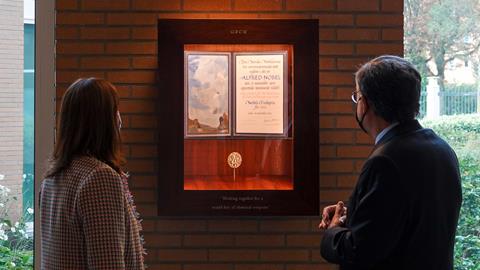
Twenty-six years on from the start of the process of monitoring and overseeing the destruction of these stockpiles, over 70,000 tonnes of chemical weapons have been destroyed. The remaining declared stockpiles still to be destroyed are in the US, mostly mortar bombs filled with sulfur mustard and rockets containing sarin. The outstanding 127 tonnes of chemical munitions are now expected to be destroyed in a matter of weeks or months. This work is being carried out at two sites in the US, the Blue Grass facility in Kentucky and the Pueblo Chemical Depot in Colorado.
Over the course of the three decades that the OPCW has been operating it has conducted more than 10,000 missions. In recent years, this has seen the organisation’s scientists in Syria first to monitor the destruction of the country’s declared stockpile of nerve agent precursors and mustard gas munitions, and then to investigate the use of chlorine and sarin in the ongoing civil war. The chemical weapons watchdog was also involved when an attempt was made on the life of a former Russian spy living in the UK that also later resulted in the death of a bystander, helping to confirm that the chemical used in the attack was a Novichok nerve agent. The OPCW also provided technical assistance following the assassination of the brother of Kim Jong-un with the nerve agent VX at Kuala Lumpur airport in Malaysia. The complexity of these kinds of recent missions – working with biological samples from warzones and novel chemical weapons – are part of the reason the OPCW needs new facilities to address the changing nature of chemical weapon use.
An old problem: legacy chemical weapons
Beyond the declared stockpiles covered under the chemical weapons treaty, the OPCW also has a less well known role dealing with an old problem: legacy chemical weapons. Around 20 countries have declared that they have a problem with chemical weapons leftover from past wars that are no longer viable chemical munitions but nevertheless still pose a danger to the public. These countries stretch from Europe, North America, Asia and even to the Pacific islands. Among the legacy chemical weapons are shells containing chlorine from the first world war that are still routinely discovered in France and other countries, and munitions from the second world war that Japan left behind during its retreat from China.
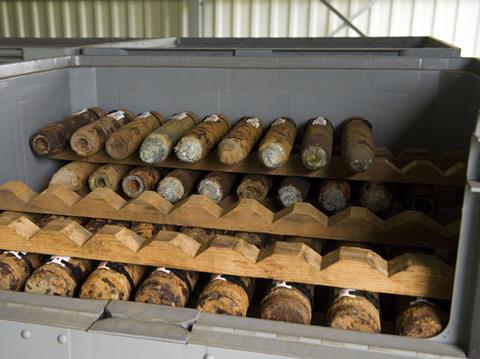
Good vibrations
The ChemTech centre was constructed on top of 197 concrete piles sunk 24m into the ground. This provides a solid foundation for the building that minimises vibration, so that precision measurements can be made in the lab. The new centre gives the OPCW roughly double the lab space it previously had, and it has already been fitted out with fume hoods and high resolution GC–MS, which will be the workhorses of the new lab. LC–MS and intermediate field strength NMR, along with enzyme-linked immunosorbent assays that can be used to check for exposure to chemical agents and biotoxins in biological samples, are also in the process of being installed. The state-of-the-art LC–MS will be among the most sensitive equipment for working with samples that the OPCW will possess. Given the long lead times in setting up these instruments, the lab is not expected to be fully operational until later this year.
‘The [OPCW] must keep pace with the progress in science and technology and the way it can impact the convention,’ said the organisation’s director general Fernando Arias. ‘Our new ChemTech Centre will play an essential role in ensuring the OPCW can keep up with the exponential growth in scientific knowledge and technological instruments.’
A big part of the new lab’s work will be to conduct chemical forensics on samples. By establishing which chemicals are present in a sample, including byproducts and precursors of the production process, OPCW forensics scientists can build up a chemical fingerprint of any material used in an attack. This fingerprint can provide information on the synthesis route for the chemical and can ‘give a clue where a chemical was coming from that will, in the end, point to the perpetrator’, a senior OPCW official explains. The official, who has experience of both the legacy labs and the new centre, says the ‘old labs are incomparable’ with the new, modern ones, providing more space and improved facilities and equipment.
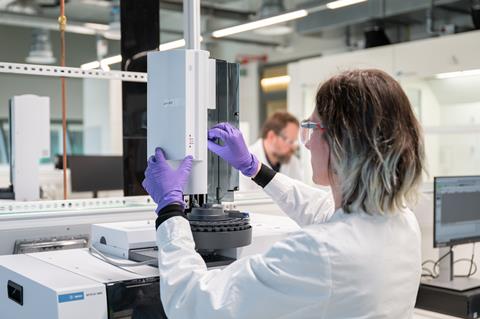
Alastair Hay, a toxicologist who sat on the OPCW’s advisory board for education and outreach from 2016 to 2021, says that he had heard the complaints that the old lab and training facilities were outdated. Hay notes that the OPCW’s aims have ‘expanded hugely’ in recent years and that to deal with issues such as quality control limitations in testing, and to perform more tests on biological samples from victims exposed to a hazardous chemical – where soil sampling might have sufficed in the past – the organisation ‘needs space, needs time and needs to do the training’. ‘Looking at chlorine [when there’s the suspicion it’s been used as a chemical weapon] – that’s really difficult to detect in the environment,’ he notes. ‘The OPCW and some labs around the globe can measure biosamples, such as Porton Down [the site of the UK’s OPCW designated lab], but there’s always an interest in looking at new biomarkers, markers of exposure.’
The next generation
The ChemTech centre has another important role: as the training ground for tomorrow’s chemical weapon experts. The OPCW has been something of a victim of its own success, seeing global chemical weapons’ expertise dwindle as a result of militaries around the world ending their chemical weapons programmes. Consequently, the centre will use its new labs to teach the next generation of experts in chemical forensic techniques to highly exacting standards, which they can then take back to their own country. ‘Enhancing capacity building for experts of the OPCW and its member states is a key to better implement the Chemical Weapons Convention,’ said Arias. ‘The advanced training facility of the ChemTech Centre will strengthen national and regional emergency response capabilities against chemical incident.’
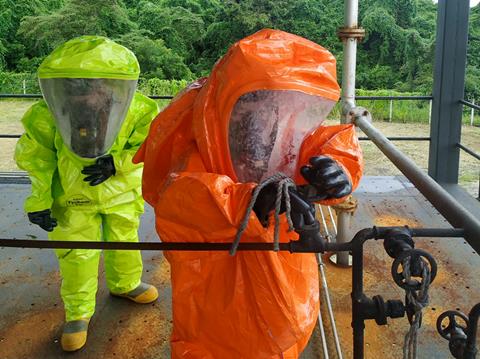
The OPCW already depends on a network of 30 designated labs spread around the world that it works with on testing and training. When a sample comes in, the OPCW’s first job is to safely split up the sample, package it up and send it to its trusted partner labs – this ensures impartiality and that the work is seen to be done completely independently. The organisation both recruits from these partner labs and will now be training people who are likely to end up working in them. Currently, Africa is the only inhabited continent that doesn’t have a designated lab. But Nigeria, Morocco, Algeria, Kenya and South Africa are now nearing designated status.
Training is set to begin in earnest in June with the OPCW hoping to train several hundred people at its new centre every year. A senior OPCW official with experience organising training says that the organisation needs more designated labs and that the new facility will ‘give us the opportunity to do the training more intensively’. She adds that the organisation is now ‘trying to introduce more and more e-modules’ to train scientists around the world. This is one lesson that the OPCW learnt during the pandemic – that it simply isn’t possible to do every course in person and that there is room for more online and virtual training.
‘Because the facility is big, [the OPCW] are going to use it for workshops and training. That was the idea behind it – they want it for a variety of reasons,’ Hay explains. He predicts that kitting the lab out with better equipment and instruments will mean it’s easier for the OPCW to do more outreach work, where it brings people in from around the world for training. Hay says he is now looking forward to seeing the new facilities for the first time in June when he’ll be teaching younger students about science and diplomacy.